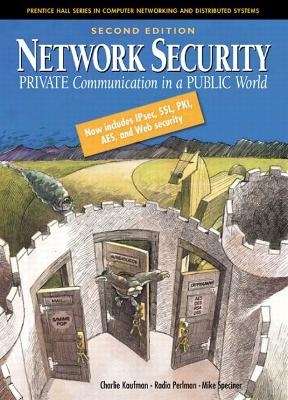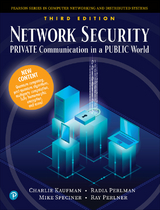
Network Security
Prentice Hall (Verlag)
978-0-13-046019-6 (ISBN)
- Titel erscheint in neuer Auflage
- Artikel merken
The world's #1 book on network and Internet security has been thoroughly updated to reflect today's latest threats, techniques, and technologies. The long-awaited Network Security, Second Edition brings together definitive, accessible, even entertaining explanations of every key facet of information security. The authors begin by reviewing the challenges of network security, and introducing basic concepts such as authorization and the "military model" of security. They present an easy-to-understand introduction to cryptography, including secret and public keys, hashes, and message digests. A detailed section on authentication addresses the challenge of proving identity across the network; handshakes; and common attacks that must be addressed in designing authentication systems. The authors address core Internet security standards including Kerberos 4/5, PKI, IPSec, and SSL; as well as e-mail security via PEM, S/MIME, and PGP. They offer practical introductions to the Web security issues associated with URLs, HTTP, HTML, and cookies; concluding with overviews of security in environments ranging from Windows to NetWare.
CHARLIE KAUFMAN is a Distinguished Engineer at IBM, where he is Chief Security Architect for Lotus Notes and Domino. Previously, he was the Network Security Architect at Digital Equipment Corporation. He chaired the IETF's Web Transaction Security working group and currently serves on the IAB, the IETF's architecture board. RADIA PERLMAN, Distinguished Engineer at Sun Microsystems, is known worldwide for her contributions to bridging (spanning tree algorithm) and routing (link state routing) as well as security (sabotage-proof networks). Perlman is the author of Interconnections: Bridges, Routers, Switches, and Internetworking Protocols, and she is one of the 25 people whose work has most influenced the networking industry, according to Data Communications magazine. MIKE SPECINER is a Senior Consulting Engineer at ThinkEngine Networks and is a recognized expert in mathematical algorithms and operating systems. Combined, this author team holds close to 100 patents.
Acknowledgments.
1. Introduction.
Roadmap to the Book. What Type of Book Is This? Terminology. Notation. Primer on Networking. Active vs. Passive Attackc. Layers and Cryptography. Authorization. Tempest. Key Escrow for Law Enforcement. Key Escrow for Careless Users. Viruses, Worms, Trojan Horses. The Multi-level Model of Security. Legal Issues.
I. CRYPTOGRAPHY.
2. Introduction to Cryptography.
What Is Cryptography? Breaking an Encryption Scheme. Types of Cryptographic Functions. Secret Key Cryptography. Public Key Cryptography. Hash Algorithms. Homework.
3. Secret Key Cryptography.
Introduction. Generic Block Encryption. Data Encryption Standard (DES). International Data Encryption Algorithm (IDEA). Advanced Encryption Standard (AES). RC4. Homework.
4. Modes of Operation.
Introduction. Encrypting a Large Message. Generating MACs. Multiple Encryption DES. CBC Outside vs. Inside. Homework.
5. Hashes and Message Digests.
Introduction. Nifty Things to Do with a Hash. MD2. MD4. MD5. SHA-1. HMAC. Homework.
6. Public Key Algorithms.
Introduction. Modular Arithmetic. RSA. Diffie-Hellman. Digital Signature Standard (DSS). How Secure Are RSA and Diffie-Hellman? Elliptic Curve Cryptography (ECC). Zero Knowledge Proof Systems. Homework Problems.
7. Number Theory.
Introduction. Modular Arithmetic. Primes. Euclid's Algorithm. Chinese Remainder Theorem. Zn. Euler's Totient Function. Euler's Theorem. Homework Problems.
8. Math with AES and Elliptic Curves.
Introduction. Notation. Groups. Fields. Mathematics of Rijndael. Elliptic Curve Cryptography. Homework.
II. AUTHENTICATION.
9. Overview of Authentication Systems.
Password-Based Authentication. Address-Based Authentication. Cryptographic Authentication Protocols. Who Is Being Authenticated? Passwords as Cryptographic Keys. Eavesdropping and Server Database Reading. Trusted Intermediaries. Session Key Establishment. Delegation. Homework.
10. Authentication of People.
Passwords. On-Line Password Guessing. Off-Line Password Guessing. How Big Should a Secret Be? Eavesdropping. Passwords and Careless Users. Initial Password Distribution. Authentication Tokens. Physical Access. Biometrics. Homework.
11. Security Handshake Pitfalls.
Login Only. Mutual Authentication. Integrity/Encryption for Data. Mediated Authentication (with KDC). Nonce Types. Picking Random Numbers. Performance Considerations. Authentication Protocol Checklist. Homework.
12. Strong Password Protocols.
Introduction. Lamport's Hash. Strong Password Protocols. Strong Password Credentials. Strong Password Credentials Download Protocols. Homework.
III. STANDARDS.
13. Kerberos V4.
Introduction. Tickets and Ticket-Granting Tickets. Configuration. Logging Into the Network. Replicated KDC's. Realms. Interrealm Authentication. Key Version Numbers. Encryption for Privacy and Integrity. Encryption for Integrity Only. Network Layer Addresses in Tickets. Message Formats. Homework.
14. Kerberos V5.
ASN.1. Names. Delegation of Rights. Ticket Lifetimes. Key Versions. Making Master Keys in Different Realms Different. Optimizations. Cryptographic Algorithms. Hierarchy of Realms. Evading Password-Guessing Attacks. Key Inside Authenticator. Double TGT Authentication. PKINIT-Public Keys for Users. KDC Database. Kerberos V5 Messages. Homework.
15. PKI (Public Key Infrastructure).
Introduction. Some Terminology. PKI Trust Models. Revocation. Directories and PKI. PKIX and X.509. X.509 and PKIX Certificates. Authorization Futures. Homework.
16. Real-time Communication Security.
What Layer? Session Key Establishment. Perfect Forward Secrecy. PFS-Foilage. Denial-of-Service/Clogging Protection. Endpoint Identifier Hiding. Live Partner Reassurance. Arranging for Parallel Computation. Session Resumption. Plausible Deniability. Data Stream Protection. Negotiating Crypto Parameters. Easy Homework. Homework.
17. IPsec: AH and ESP.
Overview of Ipsec. IP and Ipv6. AH (Authentication Header). ESP (Encapsulating Security Payload). So, Do We Need AH? Comparison of Encodings. Easy Homework. Homework.
18. IPsec: IKE.
Photuris. SKIP. History of IKE. IKE Phases. Phase 1 IKE. Phase - 2 IKE: Setting up Ipsec Sas. ISAKMP/IKE Encoding. Homework.
19. SSL/TLS.
Introduction. Using TCP. Quick TCP. Quick History. SSL/TLS Basic Protocol. Session Resumption. Computing the Keys. Client Authentication. PKI as Deployed by SSL. Version Numbers. Negotiating Cipher Suites. Negotiating Compression Method. Attacks Fixed in v3. Exportability. Encoding. Further Reading. Easy Homework. Homework.
IV. ELECTRONIC MAIL.
20. Electronic Mail Security.
Distribution Lists. Store and Forward. Security Services for Electronic Mail. Establishing Keys. Privacy. Authentication of the Source. Message Integrity. Non-Repudiation. Proof of Submission. Proof of Delivery. Message Flow Confidentiality. Anonymity. Containment. Annoying Text Format Issues. Names and Addresses. Verifying When a Message Was Really Sent. Homework.
21. PEM & S/MIME.
Introduction. Structure of a PEM Message. Establishing Keys. Some PEM History. PEM Certificate Hierarchy. Certificate Revocation Lists (CRLs). Reformatting Data to Get Through Mailers. General Structure of a PEM Message. Encryption. Source Authentication and Integrity Protection. Multiple Recipients. Bracketing PEM Messages. Forwarding and Enclosures. Unprotected Information. Message Formats. DES-CBC as MIC Doesn't Work. Differences in S/MIME. S/MIME Certificate Hierarchy. Homework.
22. PGP (Pretty Good Privacy).
Introduction. Overview. Key Distribution. Efficient Encoding. Certificate and Key Revocation. Signature Types. Your Private Key. Key Rings. Anomalies. Object Formats.
V. LEFTOVERS.
23. Firewalls.
Packet Filters. Application Level Gateway. Encrypted Tunnels. Comparisons. Why Firewalls Don't Work. Denial-of-Service Attacks. Should Firewalls Go Away?
24. More Security Systems.
NetWare V3. NetWare V4. KryptoKnight. DASS/SPX. Lotus Notes Security. DCE Security. Microsoft Windows Security. Network Denial of Service. Clipper. Homework.
25. Web Issues.
Introduction. URLs/URIs. HTTP. HTTP Digest Authentication. Cookies. Other Web Security Problems. Homework.
26. Folklore.
Perfect Forward Secrecy. Change Keys Periodically. Multiplexing Flows over a Single SA. Use Different Keys in the Two Directions. Use Different Secret Keys for Encryption vs. Integrity Protection. Use Different Keys for Different Purposes. Use Different Keys for Signing vs. Encryption. Have Both Sides Contribute to the Master Key. Don't Let One Side Determine the Key. Hash in a Constant When Hashing a Password. HMAC Rather than Simple MD. Key Expansion. Randomly Chosen Ivs. Use of Nonces in Protocols. Don't Let Encrypted Data Begin with a Constant. Don't Let Encrypted Data Begin with a Predictable Value. Compress Data Before Encrypting It. Don't Do Encryption Only. Avoiding Weak Keys. Minimal vs. Redundant Designs. Overestimate the Size of Key. Hardware Random Number Generators. Timing Attacks. Put Checksums at the End of Data. Forward Compatibility. Negotiating Parameters. Homework.
Bibliography.
Glossary.
Index.
| Erscheint lt. Verlag | 1.5.2002 |
|---|---|
| Reihe/Serie | Prentice Hall Series in Computer Networking and Distributed Systems |
| Verlagsort | Upper Saddle River |
| Sprache | englisch |
| Maße | 184 x 239 mm |
| Gewicht | 1266 g |
| Themenwelt | Informatik ► Netzwerke ► Sicherheit / Firewall |
| ISBN-10 | 0-13-046019-2 / 0130460192 |
| ISBN-13 | 978-0-13-046019-6 / 9780130460196 |
| Zustand | Neuware |
| Haben Sie eine Frage zum Produkt? |
aus dem Bereich



